17 3D Bioprinting
Courtney Keane
17.1 Introduction
Keywords
- 3D printing – the process of making physical/tangible objects from a three dimensional digital model, typically by laying down many thin layers of material on top of one another
- 3D bioprinting – the three dimensional printing of biological tissues and materials that often imitate human cells or tissues
- Additive manufacturing – another word for 3D printing with the same definition
- Collagen – main structural protein found in skin and other connective tissues
- Polymer – substance that has a molecular structure consisting chiefly or entirely of a large number of similar units bonded together
- Piezoelectric – involving electric polarization resulting from the application of mechanical stress
- Substrate – surface for which something is deposited or inscribed
- Thermoplastic – denoting substances (especially synthetic resins) that become plastic on heating and harden on cooling, and are able to repeat these processes
- Regenerative – able to be regenerated or reproduced
- Scaffolds – materials that have been engineered to cause desirable cellular interactions to contribute to the formation of new functional tissues for medical purposes
Learning Objectives
By the end of this chapter students should be able to:
- Understand what 3D bioprinting is
- Discuss past and current uses of this technology, along with important advancements that have been made by it in the healthcare industry
- Recall important impacts this technology has had on society and science
- Discuss possible future advancements for this technology in both the field of medicine and society
3D printing has been a key technological advancement in multiple industries over the course of more than 35 years. It has been adopted into many aspects of the engineering industry and more recently has been adopted into the healthcare industry as well. 3D printing has already produced multiple achievements in the healthcare field and continues to do so as the technology becomes more advanced and researched. Recently more research is being put into 3D printing as it becomes clear that the technology has the ability to change the healthcare industry completely. Compared to many other technologies in the healthcare system, 3D printing is still relatively new. Although it is new, the technology has the ability to do big things. In the future 3D printing will possibly be the biggest advancement that medicine has ever seen.
To make these changes in the healthcare industry that will solve many issues the field of medicine constantly deals with, the past, present and future of the technology must be understood. This chapter will focus on what 3D printing is, the past, present and future of this technology, but most importantly it will discuss the impacts it has had and will continue to have on science and society.
17.2 What is 3D Printing:
Key Takeaway
In this section we will discuss a general overview of what 3D printing is but more specifically what it has become when integrated into the field of medicine.
3D printing is a manufacturing method and process in which objects are made from layering materials on top of each other and become tangible objects. It was invented in the early 1980s by a man named Charles Hull and was mainly used in the engineering field but since has also been adopted into the field of medicine. It has been tested in many different applications over the course of 30 years which have had a great impact on the healthcare industry and continues to do so. When it was introduced into the field of medicine, 3D printing became bioprinting, which was using biological materials to replicate living human cells and tissues. The goal for 3D bioprinting was to create functional organs out of biological materials but as of now, the technology is not advanced enough to do so.
There are many different forms of bioprinting in medical applications, these include: Selective Laser Sintering (SLS), Thermal Inkjet Printing (TIJ), and Fused Deposition Modeling (FDM) (Ventola C. Lee, Oct 2014). These different types of printers use different types of materials and processes to create the 3D objects. Selective laser sintering or SLS uses powdered materials as the substrate. The laser draws shapes in this powder to create the object. This type of printing is best to create metal, plastic, or ceramic objects. Thermal inkjet printing is another type of 3D printing that uses thermal, electromagnetic, or piezoelectric technology to deposit ink onto a substrate. This type of printing is promising for tissue engineering and regenerative medicine because of the precision, control and versatility in the printing. This has been applied to print simple tissues and organs (Ventola C. Lee, Oct 2014). Fused deposition modeling printing uses a printhead similar to the TIJ printer. The printed parts are also made from thermoplastics used by the TIJ printer.
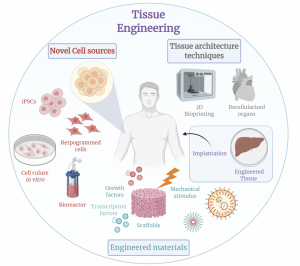
“Tissue Engineering Schematic “ by Annisasp is licensed under CC BY-SA 4.0
17.3 History of 3D Bioprinting:
Key Takeaway
3D bioprinting was first introduced into the field of medicine when researchers at the Boston Children’s Hospital at Harvard medical school created the first 3D (hand built) urinary bladders by constructing scaffolds from collagen and polymer and then layering them with cells from patients to grow into functioning organs (Whitaker, Matthew, June 2014). The leader of this research team then moved to Wake Forest Baptist Medical Center in 2004 to lead the Wake Forest Institute for Regenerative Medicine (WFIRM). At this school machines were built that could print out customized scaffolds for human organs. Since then researchers have been able to engineer several categories of tissues and organs by hand, this research has been continuing but is not yet ready for clinical use.
Since the early 2000’s 3D printing in medicine has made multiple advancements. In 1999 the first urinary bladder was created by hand by layering scaffolding on top of each other by the researchers mentioned above. Since then, scientists have engineered a multifunctional kidney, functional prosthetics (without changes made by man), created the first bioprinted blood vessel, created dental implants and also implanted a 3D printed prosthetic jaw. The timeline in figure 17.3.1 shows when these inventions and advancements took place. This includes many past uses as well as more recent uses of 3D printing technology. More current medical uses of this technology can be put into three categories, these include: “tissue and organ fabrication; creating prosthetics, implants, and anatomical models; and pharmaceutical research concerning drug discovery, delivery and dosage” (Ventola, C. Lee, Oct 2014). These applications of 3D printing used by the field of medicine have caused many changes within the industry. When the first concept of 3D bioprinting was introduced into the healthcare industry, regenerative medicine was greatly impacted. Scientists and researchers saw 3D bioprinting (by hand at first) as having a huge effect on the concept and development of regenerative medicine. The greatest advantage that has been seen thus far has been the freedom to produce custom made medical products and equipment. Scientists now saw a new type of healthcare that could focus more on patient individuality and change the way the healthcare system worked in general.
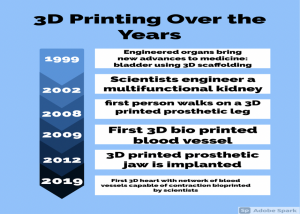
Created by Courtney Keane
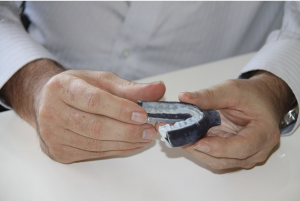
“Hands Holding a 3D Printed Mouth Piece” by CSIRO is licensed under CC BY 3.0
17.4 Impact of 3D Bioprinting on Society:
Key Takeaway
3D printing technology is still in its infancy, because it is so new the impacts it can have on society are still being researched and questions of effects are still being asked. In the field of medicine, technology must be precise and beneficial to the patients and workers, new technology can sometimes be seen as daunting because the effects of these technologies are unknown. 3D bioprinting is a relatively new concept, and with this concept comes questions of ethics as well as debates over the pros and cons. Ethically, bioprinting is constantly questioned because of the materials that are used. Stem cells play a crucial role in this technology, because of this a lot of concern comes from the morality of using human embryonic stem cells. The lesser debated ethical questions focus on where the cells come from, the use of animals in the laboratory, and problematic techniques. 3D printing has its clear benefits but there are a lot of questions that need to be asked before this technology can be fully accepted by the public. Many people wonder if 3D printing will ever be accepted due to the fact that the cells that are used must either come from humans or other species which raises concern. With any new technology there will be people that support it and people that fight against it, because medicine is so important in everyone’s life this technology will also be an important aspect of discussion for activist groups and public officials. Legally there are also many questions that come along with bioprinting, the most important issue is lack of understanding of the technology. Without understanding the technology completely, regulating authorities may not address the use of bioprinting in hospitals or laboratories in the correct way. Legally and ethically there are many discussions to be had. Overall, bioprinting has its fair share of both pros and cons, it is ultimately up to the public to decide which weighs more.
17.4.1 Pros of 3D Bioprinting:
The benefits of additive manufacturing explain a lot about why the technology is so important to the future of medicine. 3D printing can have a huge effect on patients in the hospital, it can produce customized prosthetics and implants that can benefit the patient because it can affect recovery time. It can also be beneficial because many traditionally used prosthetics are not created for a certain individual rather they are created in a generalized way that the mechanics believe will fit everyone. If the prosthetics are custom made it can allow patients to learn to use the prosthetics much easier and faster allowing it to meet their needs. 3D bioprinting has also been a focus for the future of drug delivery and dosage. Again if drugs and medications can be customized to meet the specific needs of patients, it may be more beneficial because a lot of the time drugs are created for a generalized whole which may not allow the drug to aid in the recovery of certain patients in the correct way. A lot of the benefits that have been explained have put an emphasis on customization for patients and while it may seem repetitive, personalized medicine for patients can have a major impact on the treatment and recovery time of patients in the hospitals. 3D bioprinting can help aid patients in many difficulties faced by modern medicine, not only does it have the ability to personalize medicine for patients and benefit their experience with technology in the healthcare industry but it can also benefit the doctors and scientists that utilize these tools.
Customized implants may seem like they would only benefit patients but they can in fact benefit the nurses and doctors as well. Customized implants can change the surgery time that is required for patients and help to aid in their recovery which in turn benefits the doctors because their jobs will move along faster. 3D bioprinting can also aid in the issue of organ shortage. In the future building fully functioning organs is a goal for this technology, if fully functioning organs were able to be created through stem cells, the organ shortage would be solved which would in turn affect how fast someone who is waiting for a transplant gets one. Another benefit that can be seen in the hospital setting is that it is less costly to produce other items and tools used in the hospital if they were to be created through 3D printing. Tools and items that are expensive play a partial role in the cost of healthcare, cutting down these costs may also cut down health care costs.

“3D Printed Spine” by Andreas Koffer is licensed under CC BY-SA 2.0
17.4.2 Cons of 3D Bioprinting:
Although there are many positives that come along with 3D bioprinting, there are negative aspects of it as well. First of all, 3D bioprinting requires a lot of attention to detail, building such precise models can be difficult. Also, as of currently, the mechanical stability of 3D bioprinting/printers is not acceptable. Another problem that arises with the technology is that because it is so new it is uncertain that it will even be effective in clinical practices. Lastly, many technologies can only succeed if the public accepts it completely. In the past, reproductive cloning, a technology very similar in concept to 3D printing, was dismissed by the public because many believed that researchers and scientists were “playing God.” (Vijayavenkatarman, S, 2016) Other than this many don’t know how it will impact society, many of these cons weigh heavily in the debate of incorporation of 3D printing and must be taken into account as research of this technology progresses.
17.5 Future Outlook:
Key Takeaway
17.5.1 The Future of 3D Bioprinting
3D bioprinting as stated before is still in its infancy. It has been around for 30 years but for any one who understands technology and the way it is implemented into society understands that it takes much longer to fully be understood and used correctly. Due to the fact that this technology is being focused on use in the field of medicine, it is even more vital that the technology be fully understood and researched before it can really be used. Over the past 30 years researchers have been looking into how to make this technology better, they want to know what can be improved and with these improvements where the technology can go. Many researchers and scientists have big plans for 3D bioprinting, but before these future possibilities can be met, the technology must take small steps to move forward. This starts with even more time and research being placed into how to make the technology much more precise in creating 3D printed objects. There are also anticipated stages that researchers believe the technology must focus on before reaching its full potential, these include: stage 1: drug and cosmetic testing, stage 2: bioprinting of simple tissues, and finally stage 3: bioprinting of complex tissues and organs. It is anticipated that these stages must be followed and met in order to reach the ultimate end goal of printing fully functional organs and tissues in the future.
There are many future possibilities for this technology, as it advances, 3D bioprinting is expected to be able to create complex organs. One of the futuristic hopes for more advanced versions of this technology is known as SITU printing, this is where printing of implants or living organs would be done inside the body during operations, this would cut time in surgery and benefit both patients and surgeons. Speaking of cutting time, another goal for the technology is to screen potential therapeutic drugs on patient tissue to find out which would work best for that specific person, ultimately cutting research time down as well as costs. Another goal of this technology is to create 4D printing from it which would take 3D printing and allow objects to be made that would have self transforming abilities, in other words live cells would be able to mature after they are printed.
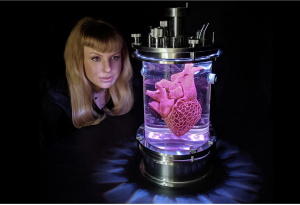
“The Heart of Evolution?” by Amy Karle is licensed under CC BY-SA 4.0
Most people like to think of 3D bioprinting as printing organs and tissues, and many don’t understand that this is not yet feasible. While in the future it would solve the issue of the organ shortage and allow patients to have organs created that have a better probability of being accepted by their bodies, the reality is that this is far off. As of current times we are almost 20 years from creating a fully functioning heart, while the research on this technology is maturing it has not yet reached a point where researchers and scientists understand how to create functional organs. There are more challenges with 3D bioprinting of organs and stem cells which means printing of full organs that work is a long way from reality. The future of 3D bioprinting is promising but before we reach that stage many obstacles must be overcome. This technology is constantly maturing and has already made incredible changes in the field of medicine, as it continues to mature it will continue to change the healthcare system as we know it.
Case Study: The Hero Arm
3D printing has infiltrated every aspect of medicine that you can imagine, multiple companies have sprung up around this technology with one being a company named Open Bionics’. Samantha Payne, the founder of Open Bionics’ Co., co-founded the company with a robotics engineer named Joel Gibbard in 2014. The company flourished due to 3D printing technology that allowed engineers to create hundreds of prosthetic arm prototypes until the perfect one was found. Eventually the prosthetic, now known as “Hero Arm” was created, it is a new type of prosthetic arm that no longer focuses on imitating a human arm but rather allows the patient to embrace the design in a way that allows them to do much more than a generalized made prosthetic. The creation of this prosthetic has also allowed artificial limb costs to be cut which could greatly impact the amount of people in need. It can also impact the waiting time of prosthetics for patients.
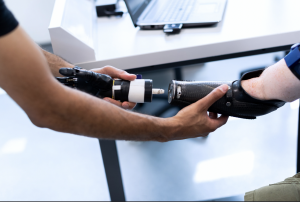
“Male Mechanical Engineer Attaches Prosthetic Arm “ by This is Engineering is licensed under CC BY-NC-ND 2.0
Chapter Summary
The healthcare industry is a key system within our society, we rely on it to keep us safe and healthy. New technology is constantly being made and researched to improve the healthcare industry, 3D bioprinting is just one example of these technologies. 3D bioprinting has been around since the 1980s and has been adopted as a key technology in the field of medicine. 3D printing is a method of printing objects by layering scaffolding on top of one another to create a three dimensional version, it has been used to make many different prosthetics and implants and continues to be researched. It is still in its infancy and has many ethical and legal concerns that accompany it. On top of these concerns many cons of this technology focus on attention to detail as well as how advanced the technology is. Despite concerns the public may have it also has many pros that accompany it as well. Additive manufacturing can be the key to solving many issues within the healthcare system such as recovery time for patients, surgery time, customization of prosthetics for patients, costs, etc… The goal for this technology is to solve the organ shortage. In the future researchers hope to be able to create fully functional organs that will allow patients in need of transplants to have more access to them. They also hope to advance drug research with this technology as well. 3D printing has come a long way in the field of medicine since its introduction and while it has made great contributions to the field it still has a long way to go.
Review Questions
1. The first stage researchers believe 3D printing should focus on is…
A. Bioprinting of simple tissues
B. Bioprinting of complex tissues and organs
C. Drug and cosmetic testing
D. None of the above
2. 3D printing was originally invented in..
A. 2001
B. 1978
C. 1990
D. 1980’s
3. A con of 3D bioprinting is that it costs more to print tools and equipment used in hospitals and ultimately increases healthcare costs.
A. True
B. False
4. Scientists can now create fully functional 3D printed organs
A. True
B. False
C. Research is still being conducted but it is in the near future
D. Research is still being conducted but we are still a long way off
Answers:
- C
- D
- B
- D
Food for Thought
- As readers, what other concerns do you believe the public may have about 3D bioprinting?
- What are some of the most important ways that 3D bioprinting has impacted the healthcare system?
- Why is it so difficult to get the public to fully accept 3D bioprinting, in other words explain why public acceptance is such a major concern for this technology.
References:
Ghomi, Efran and others (2020, October 25). Future of additive manufacturing in healthcare. Science Direct. https://www.sciencedirect.com/science/article/pii/S2468451120300507?casa_token=yC6Ov74WVPMAAAAA:Kkz8-JnHyqgGXcozQQORMZOLmkOLTyhXWcmdUEm5boDVm1yMxkrp0yHOyHmdEN1-0gQBPI33okoz
Michalski, Mark (2014, December 3). The Shape of Things to Come: 3D Printing in Medicine. JAMA Network. https://jamanetwork.com/journals/jama/article-abstract/1983687?casa_token=bPVpw2–Z58AAAAA:rjgwdkBfdQwh8-4Utk848QnKxxcxnnyPGj1tmgpov9f26gv03E5sVfFn78ekm4tsSfjUvZVpAegt
Multiple Authors (Jan 2018). Medical Applications for 3D Printing: Recent Developments. Missouri Medicine. https://www.ncbi.nlm.nih.gov/pmc/articles/PMC6139809/
Multiple Authors (2020, Nov 27). 3D Bioprinting and the Future of Surgery. US National Library of Medicine. https://www.ncbi.nlm.nih.gov/pmc/articles/PMC7728666/
Open Bionics (Date Unknown). Open Bionics’ Releases Affordable 3D Printed Bionic Arm. Internet of Business. https://internetofbusiness.com/open-bionics-hero-arm/
Price, Dan. The History of 3D Printing- From Kidneys to Cars. CloudTweaks. https://cloudtweaks.com/2015/03/3d-printing-history-organs/
Ventola, C. Lee (2014, Oct. 10). Medical Applications for 3D Printing: Current and Projected Uses. US National Library of Medicine. https://www.ncbi.nlm.nih.gov/pmc/articles/PMC4189697/
Vijayavenkataraman, S. (2016, August 9). 3D Bioprinting – An Ethical, Legal and Social Aspects (ELSA) Framework. Science Direct. https://www.sciencedirect.com/science/article/pii/S2405886616300021?casa_token=ExzfRghOmY0AAAAA:qlERBN3_uDsKgnR-aA6fyknnAPkRlmqZB7sQBlJ_vEniQ97T3iRW_Vumz4byxep3TJli805okiUz
Whittakes, Matthew (2015, June 12). The History of 3D Printing in Health Care. The Bulletin. https://publishing.rcseng.ac.uk/doi/full/10.1308/147363514X13990346756481
The process of making physical/tangible objects from a three dimensional digital model, typically by laying down many thin layers of material on top of one another.
The three dimensional printing of biological tissues and materials that often imitate human cells or tissues.
Involving electric polarization resulting from the application of mechanical stress
Surface for which something is deposited or inscribed.
Denoting substances (especially synthetic resins) that become plastic on heating and harden on cooling, and are able to repeat these processes.
Materials that have been engineered to cause desirable cellular interactions to contribute to the formation of new functional tissues for medical purposes.
Main structural protein found in skin and other connective tissues.
Substance that has a molecular structure consisting chiefly or entirely of a large number of similar units bonded together.
Able to be regenerated or reproduced.
Another word for 3D printing with the same definition.

